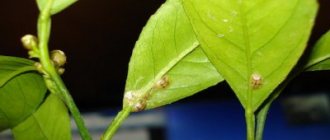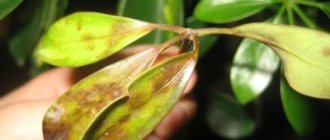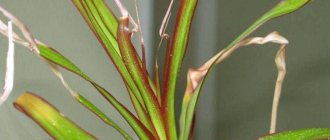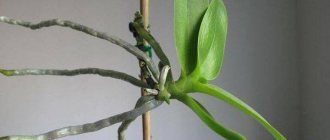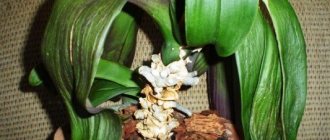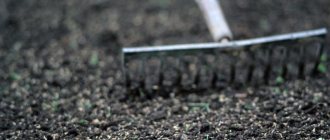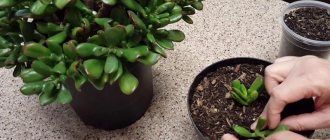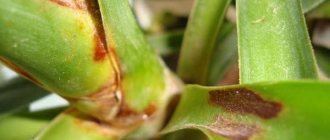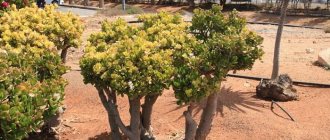Common problems
Despite the fact that the money tree can hardly be called whimsical, there are still a huge number of reasons why it can begin to fade and soon disappear completely. For example, some of them:
Overflow
For this plant, as for any other succulents, it will be safer to have a lack of moisture in the substrate than to have an excess of it. Symptoms include loss of leaf elasticity, darkening of the stem, after which the leaves themselves become first yellow and then brown. How to water properly, read in a separate article.
Diagnosis of the cause includes a careful examination of the earthen clod: if it is too wet, then this is definitely waterlogging. Also, do not think that the white coating on the surface of the substrate is rot. This way the lime from hard water comes out.
Incorrect temperature
High room temperatures can cause the leaves of this plant to fall off. If the situation is corrected in time, they will begin to grow back quickly. Those that have already turned yellow but continue to hang on the stem should be discarded.
Illumination
Most often, flower growers encounter this problem in the fall and winter, and it is at this time that the signs of crassula wilting are more pronounced than usual. In case of excessive lighting, you can observe redness of the leaves of the money tree. To correct the situation, it is enough to move it to another window sill or away from the previous one.
Diseases
One of the most common is fusarium rot , which occurs due to excess moisture in the substrate.
New shoots die very quickly, the leaves turn yellow and fall off, the stem becomes limp and brown.
This also includes the appearance of a white flour coating on the leaves, which has a specific odor. Called powdery mildew.
All leaves or parts of the plant affected by such infections must be promptly removed so that the disease does not affect the entire plant and spread to healthy ones.
Important! A coating of white or silvery flowers on the leaves may not be a disease. It is necessary to carefully examine the plant for other symptoms of the disease. If none are found, this means that the plant is simply recovering from recent stress and should not be interfered with.
Pests
The appearance of white cotton wool on the soil, stem and leaves is a mealybug. To get rid of this pest, it is enough to thoroughly but gently rinse the leaves with running water. If desired, you can treat the leaves and sinuses with garlic solution or alcohol.
And in hot weather, you can encounter such a phenomenon as shedding of leaves and an abundance of elongated bugs on the plant, which are called tripas.
Spider mites leave small yellow dots on the stem and leaves, which then turn into brown scabs; sometimes you can see small white and red beetles. This pest can also be recognized by the appearance of a cobweb that entangles almost all the leaves.
Washing the plant with running water and treating it with a soap solution or any insecticidal agent will help you cope with it. Then put a cellophane cap on the flower and repeat this procedure a week later.
Yellow and brown spots on the leaves are signs of the appearance of scale insects , which are these spots. Insects must be removed manually, and then the leaves of the money tree must be wiped with a soap solution or a special preparation intended for this purpose - Fitoverm.
Why do milk thistle leaves disappear at home?
If milk thistle leaves turn yellow and droop, this can happen for several reasons:
- Lack of light . The flower may be on the north or northeast side.
- Excessive watering Causes soil rotting. Also avoid watering with cold tap water, which causes yellowing of the leaves. Too long intervals between waterings are also unacceptable.
- Lack of light and too low room temperature Can be fatal.
- excessive fertilization . Excessive consumption of mineral salts and elements will lead to yellowing and death of leaves.
- Excessive UV radiation Gives the plant a dull and lifeless appearance. Read about why leaves become dull and wrinkled and what can be done about it in a separate article.
- Pathogenic microorganisms in the soil, roots and leaves Because of this, the leaves lose their vitality and fall off. Germs and fungi can invade the soil in very wet or hot conditions.
Important! If you don't give the tree enough rest in time, it will begin to wither. In such conditions, it is unlikely that leaves will fall off.
We recommend:
- How to care for succulents
- How to care for a nolina plant
- Types of cacti and how to care for them
- How to revive cyclamen at home
- How to replant an old aloe vera with a long stem
- How Dracaena blooms in a home photo.
- How Schefflera thrives at home
What if the leaves wither?
When such a problem occurs, first of all you need to pay attention to how moist the soil is. The reason lies either in drought or in excess moisture in the substrate.
In the first case, the leaves gradually wither and take on a yellow tint, and in the second, along with the leaves, the stem begins to wither, becoming brown and soft. Read more about the problem here.
Reference! For a money tree, excess moisture is many times more dangerous than drought, as for any other succulent, but this does not mean that the plant can not be watered at all.
If the watering regime is normal, the substrate is not too wet, the problem is what kind of water is used: too cold can cause the fat plant to wilt. This must be done with settled water at room temperature.
Diagnosis of rotting Crassula
Crassula is thermophilic and requires moderate moisture.
Main problems when growing:
- loss, softening or discoloration of leaves;
- the appearance of pigmentation on the leaves;
- rotting of the stem and roots.
A change in appearance indicates the appearance of some disease. It is important to detect it in time and prevent recurrences.
Let's consider rotting, or ammonification, that is, the destruction by bacteria of organic substances containing nitrogen or a disease manifested in browning and rotting of parts or the whole plant. The cause is often fungi, but there are also bacterial rots, or bacterioses. There are lesions of the root system, trunks and branches, leaves, berries and fruits. The process of decay occurs everywhere, including in indoor flowers. How to determine that rotting has begun? This can be detected by appearance and smell.
Remember! Study the roots carefully! Their change does not always indicate rotting.
trunk
With excess moisture in winter or lack of light in summer, the Crassula stem can stretch, distort and rot. As a rule, rotting of the trunk indicates this process at the roots of the plant. A characteristic sign is stickiness at the base of the stem and an unpleasant odor.
Crassula requires varying degrees of moisture in winter and summer. In winter, the likelihood of diseases occurring is higher.
Roots
If the fat plant has been in the sun for a long time without watering and its roots have changed, water the flower a little.
When the wrinkled and dried rhizome takes on its usual appearance, you can proceed to regular watering in the usual amount. When the roots of a flower rot, the growth process stops, the leaves wither and turn yellow. To inspect the roots, the flower must be removed from the container. The rhizome softens to a gray-brown color, and the root hairs dry out. When a flower is removed, some of the roots remain in the soil; they are slimy and have a musty smell. If the damage is severe, then the outer layers of the root and stem begin to peel off.
The lateral and central roots turn brown and rot. They are often caused by pathogenic microorganisms. These include fungi that cause such rots as fusarium, verticillium, white sclerotal, gray, late blight, as well as bacteria that cause bacterial rot.
Are the Crassula leaves falling off?
The money tree reproduces mainly with the help of leaves , and their shedding tells us that the plant is in uncomfortable conditions and wants to get rid of offspring in order to maintain its vital functions.
The conditions in which the fat plant is kept play a big role here: insufficient lighting in winter, when the plant is weakened. Also, a large accumulation of moisture in the drainage during the cold season can negatively affect the appearance of the money tree. But most often it is excessive fertilization of the plant.
To solve this problem, you will have to gradually eliminate problems from the list one by one: first check the drainage layer, adjust the watering regime (1-2 times a month in winter), move the plant to a well-lit windowsill and fertilize with the correct frequency.
All conditions must be met according to the time of year: in the fall - winter there is a period of dormancy, and the rest of the time - growing season.
How to save a money tree that is withering and dying?
One of the most common succulents on window sills in Russia is Crassula ovate. It is better known by its second name - money tree. The plant received it for the resemblance of its round, small leaves to coins.
Caring for crassula at home is not at all difficult:
- it does not require special attention;
- Tolerates drought well;
Healthy Crassula tree
However, excessive care and inexperience of novice gardeners can destroy or significantly damage the plant.
If the plant is in very poor condition, feed the Crassula after replanting and watering. When watering, add one of the following drugs to the water: Epin, Kornevin, Zircon. Follow the instructions carefully.
What to do if the roots have rotted?
Signs of rotting of the roots of the fat plant are their darkening , and if the process began a long time ago, then the rot spreads to the trunk, making it soft and dark. In this case, emergency measures must be taken.
You need to carefully rinse the earthen lump with warm water so that the damaged areas are visible, after which they need to be removed with a sharp knife or scissors.
The healthy part of the rhizome should be placed in a solution of potassium permanganate for 20 - 25 minutes for disinfection.
Under no circumstances should you plant the remaining healthy part of the rhizome in the same soil , because it is also infected, and you can only get rid of it.
The empty container must be washed with laundry soap and rinsed with boiling water. Only after these manipulations can a money tree be placed there.
Features of the root system when replanting a tree
As for young plants of this species, planted in temporary pots, they must be left there for a period of several days for adaptation. Only after the young Crassula has “adapted” to the new place can it be transplanted into a pot where it will continue to grow.
In general, the reasons for transplantation can be the following:
- Diseased root system.
- The soil in the pot is very depleted.
- The root system has grown too large.
For the growth of this plant, it does not require a lot of nutritious soil; it itself can accelerate the development of the necessary substances in it, so the Money Tree adapts to life even in poor soil. However, sometimes it is necessary to replace the soil with fresher soil to prevent the plants from looking unsightly or sickly.
The root system of the money tree is very shallow and shallow. If rot on the roots or other diseases is detected, it is necessary to urgently replant the plant, completely replace the soil, and remove the rotted or damaged section of the root.
Is the plant frozen?
This plant can withstand any temperature above 0 degrees, but if it turns out that it is still frozen, then you need to cut off the frozen parts and sprinkle the cut areas with crushed charcoal. In most cases, the plant recovers and continues to grow. More details about winter care in a separate article.
If you don’t want to take risks, you can cut off several whole parts and thereby propagate the plant by cuttings, so you will have a whole healthy plant.
Useful video
We invite you to watch a video about preventing rotting of Krasula roots:
If you find an error, please select a piece of text and press Ctrl+Enter.
Many people have a money tree in their apartments. This is an unpretentious indoor plant. It suffers little from pests, but often rots due to improper care.
This article explains how and why the money tree rots, as well as how to save the plant.
How to understand that Crassula has rotted?
Fungi or bacteria are to blame for money tree rotting. Roots and trunks most often rot, but branches, leaves and fruits can also rot. The process of decay is noticed by a change in the appearance of the plant.
Roots
Yellowing and wilting of leaves are the first signs of root rot. When rotting, the root hairs dry out, and the rhizome becomes soft and gray-brown in color.
To inspect the plant, it is removed from the container. Some of the roots will remain in the pot with soil; they will be slimy and have an unpleasant odor. With severe damage, the outer layers of the stem and roots peel off, and the central and lateral roots turn brown and begin to rot.
Trunk
When the trunk rots, the leaves wrinkle or become soft, stickiness appears at the base of the stem, the trunk bends or stretches, and all this is accompanied by an unpleasant odor.
Why the fat plant can rot: reasons
The reasons for the rotting of the trunk and roots of the fat plant are the same:
There are reasons for rotting that are not related to plant care - the appearance of bacteria:
- Gray mold affects the vascular system of fat plants. It spreads throughout the plant through the roots. From the outside, this is noticeable by the appearance of soft brown areas on the flowers, which increase over time.
- Late blights (fungi) appear on the root collar of the money tree. They most often develop in young plants grown from seeds. As a result, blackleg disease develops.
- Bacterial rot. External changes, as with fungal diseases.
